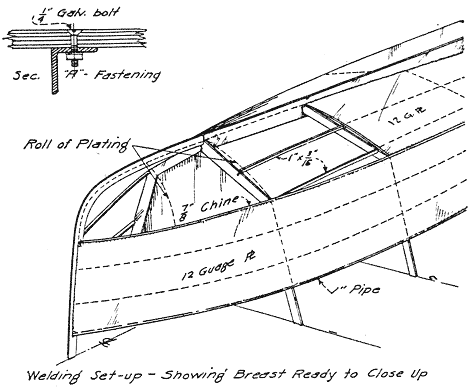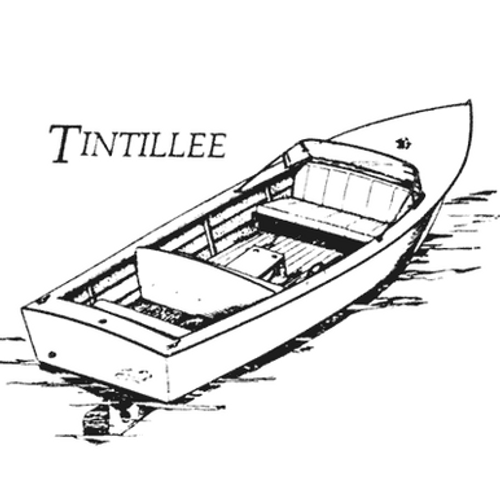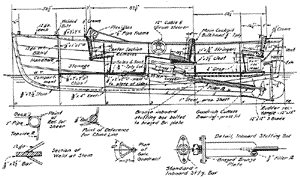"TINTILLEE" - 18' Utility style inboard launch, steel. Includes lines, arrangements, outboard profile, construction drawings, table of offsets, scantlings, etc. 6 sheets and article reprint.
Hot off the drawing board is this saucy little steel 18-footer, designed for the man who would rather work metal than wood

THERE ARE MANY good mechanics who do better working metal than wood. It is for this group of craftsmen that Tintillee was designed.
Built of simple 12-gauge steel arcwelded to a simple bar and pipe frame, Tintillee's construction follows the currently accepted methods of fabricating a welded steel hull.
For the building of Tintillee here is the size welder youll need: for the 3/8-inch plates and bars, use 250 amperes at 45 volts. For the 3/16-inch side frames, use about 200 amperes at 35 volts. The 12-gauge plate (7/64 inch thick) will weld up properly at lower current, say 120 to 130 amperes and not more than 30 volts. Amperes is the quantity of current, volts is the pressure. These currents will produce the proper heats. Use shielded welding rod obtainable at all welding supply stores and do all your work "down weld" That is, have the weld under the arc. Reverse polarity will help feed the weld into the seam.
Now about Tintillee herself: we have a simple V-bottom hull with the proper entrance and breast for an 18-footer which will drive from 10 to 16 miles an hour. Also, this shape will plate topside without billowing between frames.
You will notice from the lines drawing where the fore body and aft body are shown in section that there is a dotted line on the forward frames. There will be a tendency of the forward plates to spring away from the Frame. Let it. The inner 1" x 3/16" stringer bars can be sprung out to the skin, tack-welded, then welded to their slits to provide final welded security for the forward breast plates.

Because welded steel construction is slightly heavier than wood - about 20 per cent in this size boat - one cannot expect much planing action. Rather, the boat is designed as a bangabout for rough service, and will do about 10 to 12 miles an hour with a 25 hp Universal Utility Four, about 10 to 12 miles with a Gray 33 Lugger, and will do about 16 miles with a Gray 6-72, which is about the top limit of economical powering. As to building her. the Job is simple. Get a couple of 4' x 3' plywood sheets of ordinary grade, 1/4" thick and use them for a floor, laid end to end.
On this laying-out floor you fair up your lines, reproducing to full actual size the lines. It is on these body plans that you lay out the flat 3/16" x 2-1/2" bars so as to tack-weld them to size before removing and running a bead into the joints.
The keel assembly's laid out full size as per the drawing fully detailed below the lines drawing. From the keel layout plywood templates are lifted for all members.
Measure around the outer face of the stem bar on this keel drawing and cut a piece of stock for the 3/8" x 22-1/2" stem bar. Take this to any blacksmith shop, boiler shop or forge shop and have them furnace it and bend it to shape.

Cut the forefoot end of the stem bar into a V-point, so that you can
fill the weld fillet up properly.
The keel bar is 13' length of 3/8" x 4" bar. This will need no other manipulation than the flame cutting for the relief where the 1/2" x 1-1/4" steel bar skeg is welded. The skeg itself is heated and bent to shape after first drilling for the rudder pintle.
Weld the stem to the keel bar.
Next, from a piece of 3/8" x 6" strap. 10' long, flame cut the filler plate Between keel and stern tube. The waste end will form material for the upper skeg filler plate and for the horn bar and transom piece.
Weld the skeg fiUer to the keel and stem assembly, using a down weld with reverse polarity of 250 amperes at 45 volts. Also use a welding rod of not over .025 carbon content. This assembly may be tack-welded to hold it in shape before running the continuous weld. This continuous weld should be carried along a few inches at a time on both sides of the keel to avoid warping.
Note the elongated sluice hole in the stern tube just forward of the cutless bearing at the outboard end. This is for the water stream which lubricates the cutless bearings.
After the stern tube has been prepared for the inboard and outboard bearings, it is welded into the keel assembly. When this assembly has been rapped here and there into flat alignment, it is ready for erection.

Prepare some erecting sills in a location where the boat may he erected and later turned over. Rolling over will be necessary because on both outboard and inboard, your welding must be downward.
When proper sills and footing have been provided, turn, the keel assembly upside down and shore into place. Set frame No. 3, and temporarily tack it into its correct position, taking care to have it plumb and square; do this with other frames.
Next, the 12-gauge sheet for the transom may be welded to the transom frame. This frame consists of a 7/8" steel rod across the chine, and of 1" I.P.S. pipe at the corners and across the crown. The plate is cut so that it comes tangent to all frame members at greatest diameter. Thus, the rod and pipe form the corners.
The top sides may be or a single length of 12-gauge .017 carbon sheet steel 30" wide and 20' long. They are scribed, and flame cut to shape. Next, fit in the topside stringers of 3/16" x 1" strap. These go into slots torched out for them just as they'll stream into place. Now you can install the topside plates.

They must be carefully sprung in place, adjusted here and there by
clamping, and then tack-welded.
The next step is to run in the fore and aft bottom stringers. These are welded at the transom rod, run through the slots in the 3/16" x 2-1/2" bottom frames, and cut off where they stream into the chine rod at the breast. Here they are left loose, welded only after the bottom, plates are on, and then secured by tack welding when fitted.
It will be easier for the home builder to plate from the transom to about frame No. 2, then template the forward breast bibs. thus assuring a more easily handled plate which may be rolled or peened into shape.
This completes the hull proper. When all outside welds are completed, a disc sander with carborundum grit discs will fair off bumps in welding and remove rust.
The boat must now be rolled over. Auto jacks and blocking and ropes can effect this task. The boat must be leveled up again, right side up, and the inboard welds completed. When all the metal work has been welded up, you have two choices as to finishing the hull.
The best method calls for the sandblasting of the hull inside and out, with subsequent flame spraying of zinc. Steel boats I have designed are running after 15 years of service, initially plated with zinc like this.
The propeller shaft is of steel, and so also is the propeller. The Michigan Wheel Company, Grand Rapids. Michigan, is one concern, that makes steel propellers.
The rudder is of the shape shown, cut from an included rectangle 12" x 16", with 1-12" of lead. Shaped as shown it will not throw a "rooster tail". Flush topped rudders do.
Tintillee will displace close to 2,198 pounds ready to launch. The hull plating will use about 950 pounds of steel, and the framing about 854 pounds. Hull fittings and engine make up the difference.
Do not change scantling sizes - steel fools you badly on weights. Built as described you'll have a tough, serviceable, cheap boat.
WESTON FARMER
Reference books on arc welding may be had from the Lincoln Electric Co, Cleveland, Ohio.








